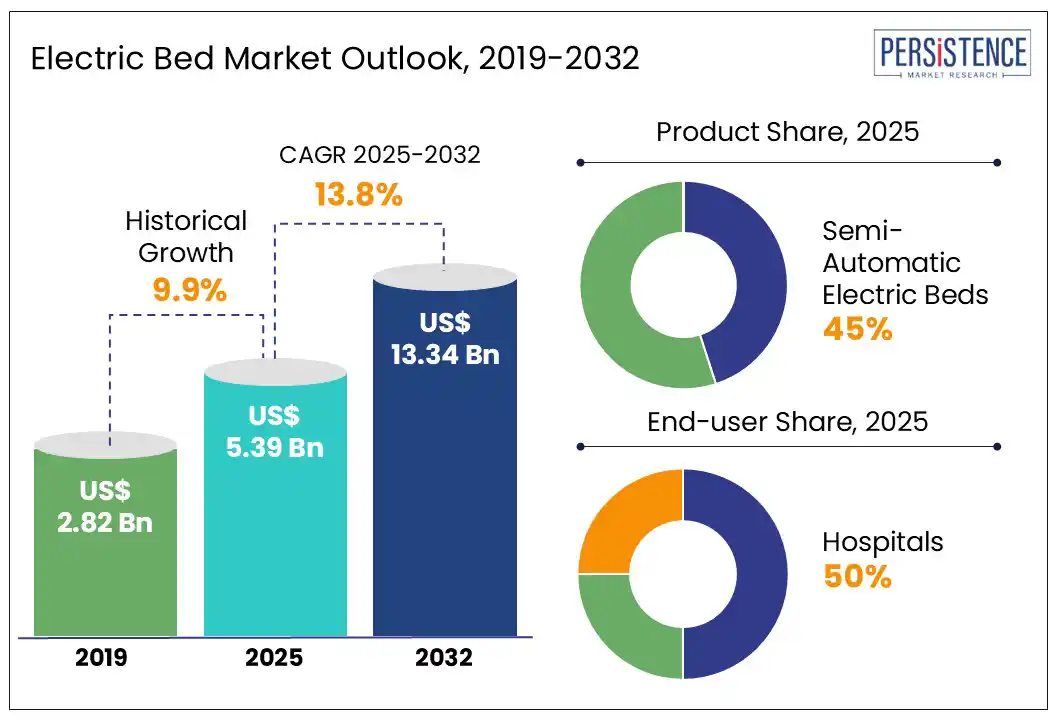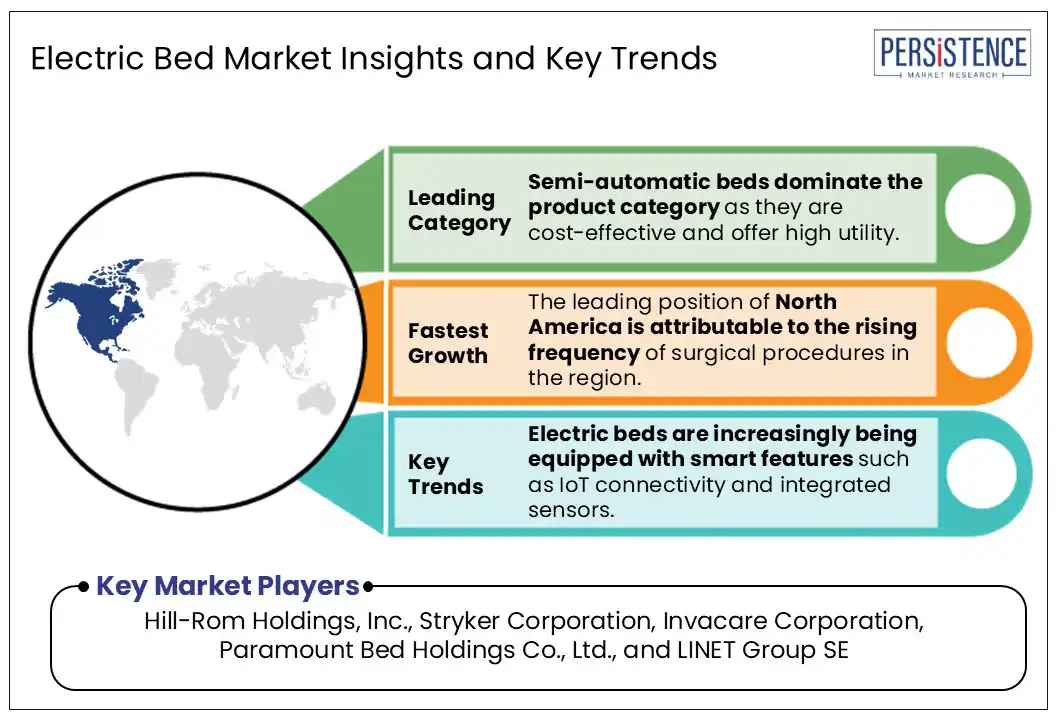ID: PMRREP35161| 250 Pages | 24 Jul 2025 | Format: PDF, Excel, PPT* | Healthcare

The global electric bed market size is likely to be valued at US$ 5.39 Bn in 2025 and is estimated to reach US$ 13.34 Bn in 2032, growing at a CAGR of 13.8% during the forecast period 2025 - 2032.
Electric beds are advanced, motorized sleep and care solutions engineered to provide maximum comfort, mobility, and wellness to users, especially the elderly users, both at home and in clinical settings. These beds are equipped with advanced technologies, such as intuitive remote controls, that allow users to adjust their head, legs, and height according to their comfort. Electronically operated beds are essential in hospitals and eldercare facilities and are increasingly used in homecare, where they support recovery, improve circulation, and help prevent pressure-related injuries.
The electric bed market is experiencing steady growth, driven by the rising geriatric population and advancements in smart healthcare technology. By 2050, individuals aged over 60 years are projected to make up 16% of the global population, increasing the demand for electric beds designed for the care and comfort of the elderly. Modern electric beds now feature integrated sensors, remote adjustability, and connectivity for real-time health monitoring, which are integral to smart hospital and homecare equipment segments. These innovations enhance patient safety and reduce caregiver workload, positioning electric beds as essential components in next-gen healthcare infrastructure.

Key Industry Highlights
| Global Market Attribute | Key Insights |
| Electric Bed Market Size (2025E) | US$ 5.39 Bn |
| Market Value Forecast (2032F) | US$ 13.34 Bn |
| Projected Growth (CAGR 2025 to 2032) | 13.8% |
| Historical Market Growth (CAGR 2019 to 2024) | 9.9% |
The electric bed market is gaining momentum globally, driven by a surge in hospital admissions due to chronic illnesses, post-operative care, and accident-related injuries. Healthcare providers are increasingly investing in electric ICU beds that offer advanced features such as height adjustability, pressure relief, and remote-controlled operation. Such features enhance both patient comfort and caregiver efficiency. In the emerging economies of Asia Pacific and Latin America, government and private sector investments in hospital infrastructure are accelerating the adoption of smart, automated medical beds. These beds are becoming essential in modern healthcare settings, meeting the growing demand for tech-enabled, ergonomic, and patient-centric care solutions.
Electric beds remain inaccessible for a large segment of the population due to their prohibitive upfront costs and inconsistent insurance reimbursement structures in different countries despite their importance in both hospitals and homecare settings. Advanced electric hospital beds with multi-motor adjustability, sensor integration, and IoT connectivity can cost between US$ 2,000 and US$ 10,000, depending on the configuration.
For a wide spectrum of long-term care patients, and even low-income families, particularly in countries such as India, Indonesia, or Brazil, where high-end healthcare equipment is either inaccessible or unaffordable, this price point acts as a significant barrier. Even in developed regions, Medicare or private insurers often cover only basic models under durable medical equipment (DME) classifications, excluding next-gen functionalities such as tilt-in-space or smart monitoring. This results in an affordability gap that is impeding the widespread adoption of such equipment in non-institutional settings.
Fragmented regulations and ambiguous reimbursement policies further compound the issue. For instance, inconsistent classification of electric beds across EU member states under the Medical Device Regulation (MDR) can delay market entry and burden manufacturers with additional compliance costs.
Aging-in-place is a fast emerging trend in developed economies and presents incredibly compelling opportunities in the electric bed market. With over 16% of the global population expected to be aged 65 or older by 2050, according to the World Health Organization (WHO), the demand for home-based healthcare solutions that offer mobility, safety, and dignity will inevitably escalate in the forthcoming years. This is fueling the adoption of smart electric beds equipped with features such as remote-controlled height adjustment, fall detection, and pressure redistribution to prevent bedsores.
Invacare Corporation and Arjo are developing smart beds tailored for homecare and are incorporated with IoT and connectivity features that enable caregivers and family members to monitor patient vitals and movement remotely. The convenience afforded by electric beds to effectively address care needs of the elderly has positioned them as one of the most essential home health tools.
At the macro level, governments and insurers are increasingly recognizing the cost-efficiency of at-home care over institutionalization. Germany’s Pflegeversicherung (long-term care insurance covers adjustable beds for home use under certain categories, while Medicare in the U.S. provides partial reimbursement for DME, including electric beds, when prescribed.
These favorable steps make the market highly elastic to policy innovation and reimbursement frameworks, enabling the creation of opportunities for manufacturers to scale their innovations focused on adjustable, IoT-enabled, ergonomic, and bariatric homecare beds. With consumers’ ability and willingness to invest in personalized comfort and safety noticeably rising, particularly in the aftermath of COVID, companies that blend health tech with home wellness are best poised to capture this rapidly evolving segment.
Based on product type, the market has been segregated into semi-automatic electric beds and fully automatic electric beds. The semi-automatic beds segment dominates the product category with a share of 45%, as these beds are cost-effective and offer high utility. This dominance is primarily due to their affordability and practical functionality.
Semi-electric beds typically include motorized adjustments for the backrest and leg elevation, enabling patients to attain comfortable positions without the intricacies or expenses linked to fully automatic models.
Healthcare facilities, especially smaller clinics and nursing homes aim to enhance patient care while adhering to financial constraints; semi-automatic electric beds provide a practical alternative. Their intuitive controls render them accessible to both patients and caregivers, thereby increasing their demand across diverse healthcare environments.
By end-user, the market is segmented into hospitals, home care, and long term nursing facility/skilled nursing facility. Hospitals are expected to lead this segment with approximately 50% market share, which can be ascribed to the rising demand for enhanced patient care, comfort, and safety. Hospitals are progressively implementing electric beds due to their sophisticated features that enhance patient comfort and facilitate medical procedures.
These beds provide effortless modifications in height and position, essential for individuals with restricted movement or those convalescing from surgery. Incorporating smart technologies, such as remote surveillance and automatic modifications, improves patient safety and caregiver efficacy, rendering these beds a preferred choice in healthcare environments.

Holding 44% of the market share, North America is set to dominate this market over the next several years. This growth is attributable to the rising frequency of surgical procedures and hospital admissions across the continent. The demand for electric beds has risen as healthcare facilities prioritize improving patient care and comfort, especially for those undergoing surgeries or needing long-term care.
North America’s aging population is contributing to an increase in chronic illnesses necessitating hospitalization, which eventually aids market growth. Statistics Canada reported that approximately 18.9% of the region's population was aged 65 years and over in 2023. The senior population frequently necessitates specialized care, and electric beds provide advantages that are especially advantageous for elderly people.
The U.S. accounts for the majority of the market share in the North American region, driven by its substantial aging population. As reported by the National Council on Aging (NCOA), around 57.8 million individuals in the country were aged 65 and over in 2022. The demographic change markedly elevates hospital admissions and surgical procedures, amplifying the demand for sophisticated medical equipment that provides improved comfort and flexibility for patients in treatment or recuperation.
The market in Europe is growing steadily due to aging population and a rising demand for advanced patient care solutions. Electric beds are increasingly used in hospitals and homecare settings to enhance mobility, comfort, and recovery. The integration of smart technologies, such as remote-controlled adjustments and sensor-based monitoring, has made these beds more adaptable and appealing to both healthcare providers and patients. As healthcare systems prioritize ergonomic, tech-enabled equipment, electric beds are becoming essential in delivering efficient and personalized care across the region.
The market for smart hospital beds in Asia Pacific is poised for strong growth, backed by an aging population and rising chronic disease rates in leading economies such as China and Japan. These nations are driving the regional demand due to their advanced healthcare infrastructure and increasing need for sophisticated, tech-enabled medical equipment. The surge in medical tourism and investments in smart hospital solutions further support market expansion. In China, for example, over 75% of individuals aged above 60 suffer from at least one chronic condition, highlighting the urgent need for electric beds that offer comfort, mobility, and remote monitoring capabilities.
The global electric bed market is highly competitive, with key players focusing on innovation, technological advancements, and strategic partnerships to expand their market share. Companies are leveraging smart bed technology and advanced ergonomic designs to meet growing healthcare demands. Rising hospital admissions and increasing home care adoption are fueling market expansion. Smaller players are gaining traction by offering cost-effective and customizable solutions. Competition intensifies as demand rises for adjustable hospital beds, smart electric beds, and homecare beds, driving new product developments and improved patient comfort solutions.
The electric bed market is projected to reach US$ 5.39 Bn in 2025.
Increasing geriatric population worldwide and a surge in hospital admissions are key market drivers.
The electric bed market is poised to witness a CAGR of 13.8% from 2025 to 2032.
Rising demand for homecare electric beds is a key market opportunity.
Hill-Rom Holdings, Inc., Stryker Corporation, and Invacare Corporation are some of the key market players.
| Report Attribute | Details |
| Historical Data/Actuals | 2019 - 2024 |
| Forecast Period | 2025 - 2032 |
| Market Analysis | Value: US$ Bn |
| Geographical Coverage |
|
| Segmental Coverage |
|
| Competitive Analysis |
|
| Report Highlights |
|
| Customization and Pricing | Available upon request |
By Product Type
By Procedure
By End-user
By Region
Delivery Timelines
For more information on this report and its delivery timelines please get in touch with our sales team.
About Author